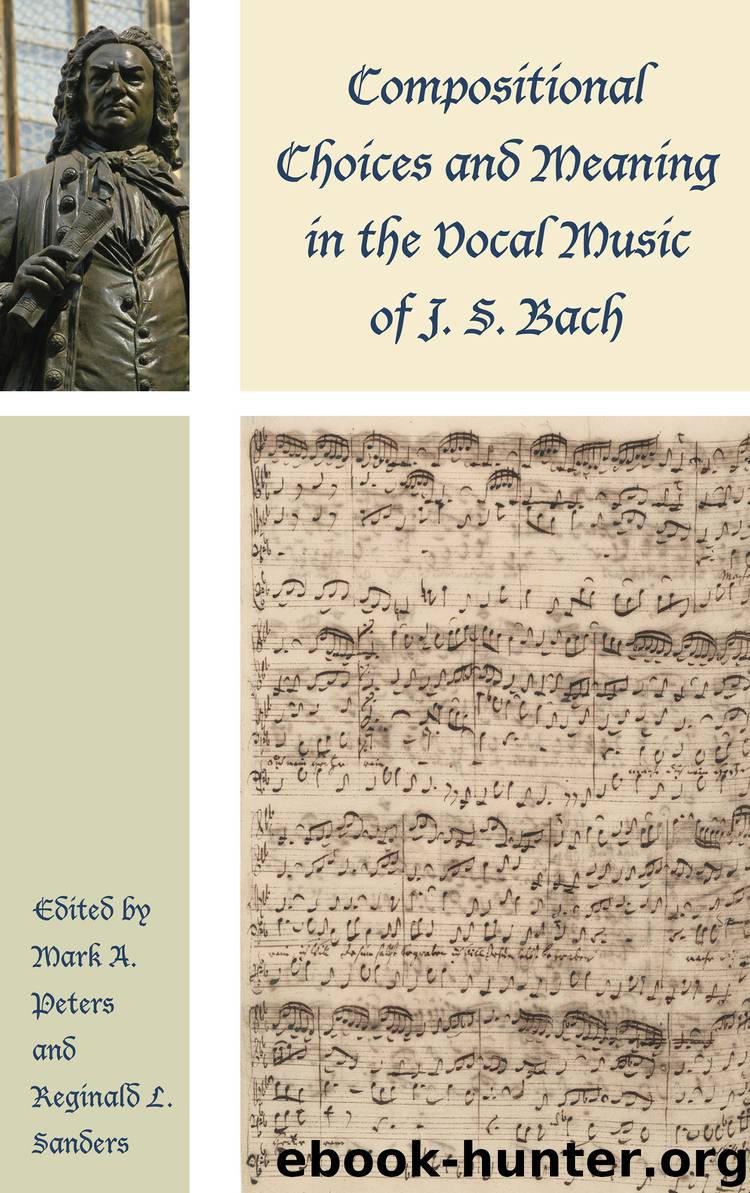Compositional Choices and Meaning in the Vocal Music of J. S. Bach by Mark A. Peters Reginald L. Sanders & Reginald L. Sanders

Author:Mark A. Peters,Reginald L. Sanders & Reginald L. Sanders [Peters, Mark A. & Sanders, Reginald L.]
Language: eng
Format: epub
Publisher: Lexington Books, a division of Rowman & Littlefield Publishers, Inc.
Published: 2018-05-08T16:00:00+00:00
Notes
1. Recent literature that concentrates on Bach’s ritornellos includes Stephen A. Crist, “Aria Forms in the Vocal Music of J. S. Bach, 1714–1724” (Ph.D. diss., Brandeis University, 1988), 111–14; Paul Brainard, “The Regulative and Generative Roles of Verse in Bach’s ‘Thematic’ Invention,” in Bach Studies, ed. Don O. Franklin (Cambridge: Cambridge University Press, 1989), 54–74; Robert L. Marshall, “The Genesis of an Aria Ritornello: Observations on the Autograph Score of ‘Wie zittern und wanken’ BWV 105/3,” in The Music of Johann Sebastian Bach: The Sources, the Style, the Significance (New York: Schirmer Books, 1989), 143–160; Paul Brainard, “The ‘Non-Quoting’ Ritornello in Bach’s Arias,” in A Bach Tribute: Essays in Honor of William H. Scheide, ed. Paul Brainard and Ray Robinson (Kassel: Bärenreiter, 1993), 27–44; Jeanne Swack, “Modular Structure and the Recognition of Ritornello in Bach’s Brandenburg Concertos,” in Bach Perspectives 4: Analysis and Interpretation, ed. David Schulenberg (Lincoln, NE: University of Nebraska Press, 1999), 33–53. The nature of these studies is mostly analytical except for Crist’s dissertation, which surveys various types of aria forms in Bach’s cantatas, organizing them according to the scoring, textual types, and aria forms. Although his discussion of Bach’s ritornellos can be defined as descriptive, his dissertation provides valuable information about the overall picture of Bach’s aria movements. My list here does not include the studies by Laurence Dreyfus and John Butt, which will be addressed in the body of the text.
2. Christoph Wolff, Johann Sebastian Bach: The Learned Musician (New York: W. W. Norton, 2000), 171.
3. See Laurence Dreyfus, Bach and the Patterns of Invention (Cambridge, MA: Harvard University Press, 1996), 59–102; an earlier discussion of Bach’s ritornello procedure is found in Laurence Dreyfus, “J. S. Bach’s Concerto Ritornellos and the Question of Invention,” The Musical Quarterly 71 (1985): 327–51.
4. Dreyfus, Bach and the Patterns of Invention, 2.
5. Dreyfus, Bach and the Patterns of Invention, 60–69.
6. Dreyfus, Bach and the Patterns of Invention, 60.
7. Dreyfus acknowledges that there are a few examples in which opening ritornellos are not tonally closed. However, he does not pay much attention to them, only suggesting that because they encapsulate the tonally closed ritornello that will play an important role in the later part of the music in question, the way it functions is not very dissimilar from the tonally closed ritornello. See Dreyfus, Bach and the Patterns of Invention, 60.
8. See John Butt, Bach’s Dialogue with Modernity: Perspectives on the Passions (Cambridge: Cambridge University Press, 2010), 269–80; Butt uses the term “tonally open ritornello,” which I have adopted for my study.
9. Butt’s research was a response to Karol Berger’s Bach’s Cycle, Mozart’s Arrow: An Essay on the Origins of Musical Modernity (Berkeley: University of California Press, 2007), in which Berger discusses in detail the opening chorus of the Matthew Passion, “Kommt, ihr Töchter, helft mir klagen,” in order to show circular stasis that represents Bach’s pre-modern orientation. Karol Berger also published the article “Time’s Arrow and the Advent of Musical Modernity,” in Music and the Aesthetics of Modernity, ed.
Download
This site does not store any files on its server. We only index and link to content provided by other sites. Please contact the content providers to delete copyright contents if any and email us, we'll remove relevant links or contents immediately.
The Goal (Off-Campus #4) by Elle Kennedy(13213)
Kathy Andrews Collection by Kathy Andrews(11347)
Diary of a Player by Brad Paisley(7272)
What Does This Button Do? by Bruce Dickinson(5938)
Assassin’s Fate by Robin Hobb(5868)
Big Little Lies by Liane Moriarty(5528)
Altered Sensations by David Pantalony(4878)
Pale Blue Dot by Carl Sagan(4634)
Sticky Fingers by Joe Hagan(3918)
The Death of the Heart by Elizabeth Bowen(3351)
The Heroin Diaries by Nikki Sixx(3329)
Beneath These Shadows by Meghan March(3158)
Confessions of a Video Vixen by Karrine Steffans(3110)
The Help by Kathryn Stockett(3024)
How Music Works by David Byrne(2969)
Jam by Jam (epub)(2882)
Harry Potter 4 - Harry Potter and The Goblet of Fire by J.K.Rowling(2818)
Strange Fascination: David Bowie: The Definitive Story by David Buckley(2704)
Petty: The Biography by Warren Zanes(2579)
